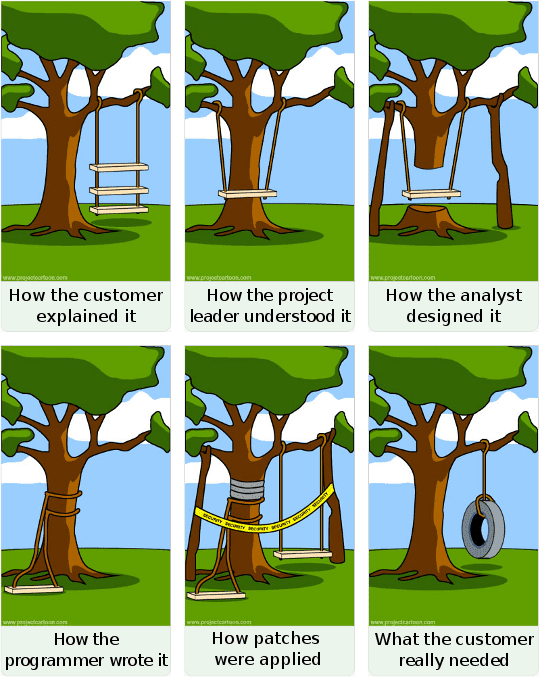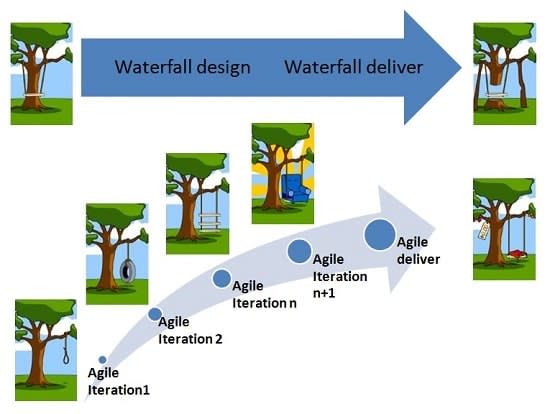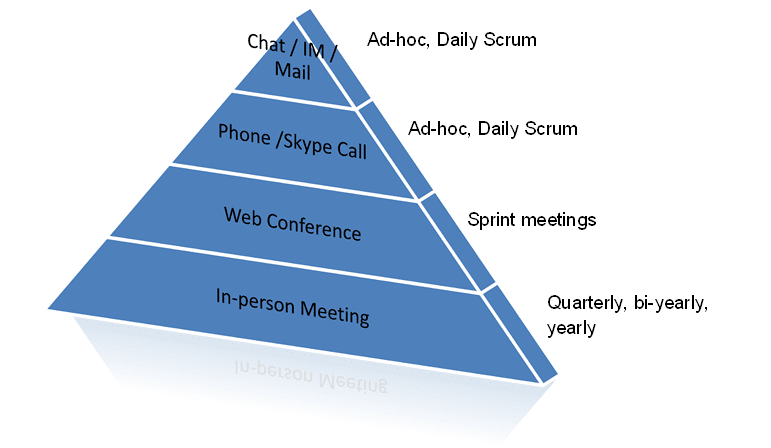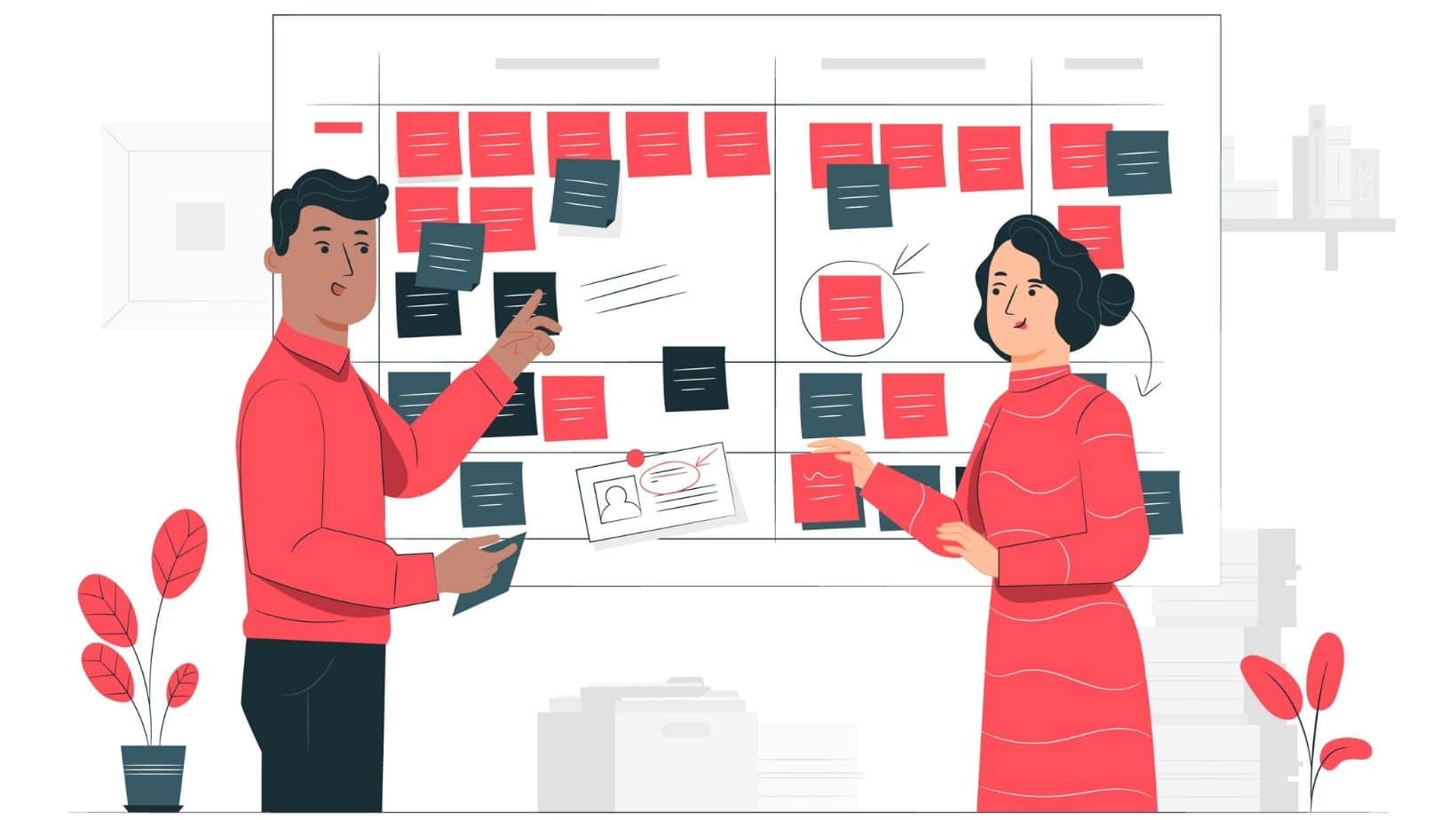Entrepreneurship is not easy.
Agree?
But isn’t it a relief if you have experienced and talented developers taking care of your product’s tech stack?
After all, they know how to approach a project, how to fix critical bugs, and how to overcome bottlenecks.
These experts are well aware of the latest trends, and software development best practices as well.
In this article, we’re diving deeper into one trending development approach i.e., the agile development process & practices.
We would also highlight why to specifically ask your software vendor or software development services provider to go agile while developing your application. At Codewave, agility is part of our culture. We know its benefits. And we don’t hold back when it comes to evangelizing growth practices.
This article would be a great read and helpful for the entrepreneurs who would want to know about outsourcing an IT project, or even if they are going for onshore/offshore development.
What’s Agile development?

Agile Methodologies
The conventional definition of agile development-
“Agile is a set of frameworks and practices for software development. The popular agile frameworks and practices include Scrum, Dynamic systems development method (DSDM), Kanban, Feature-driven development (FDD), Extreme programming (XP), Test-driven development (TDD), Pair programming (PP), stand-ups, planning sessions, and sprints.”
But the essence of agile is in flexibility, adaptability, collaboration, efficiency, and effectiveness. So, of course, the list of agile frameworks and practices is flexible too.
Read more on why agility of mind and neuroplasticity are critical for the success of agile projects.
Why agile? What’s the need for agile development?
Conventional approaches to software development were kind of okay in the 1400s. Okay, in the 1990s. But fast forward to 2022, and you would find that a 30ms delay in server response time for your website/application can mean loss of potential sales for your business.
Of course, every model has strengths and drawbacks. But the waterfall is not suited for modern web 2.0 solutions. By the way, we are already into 3.0 with the decentralized web.
Anyways, for web 2.0 waterfall is time taking i.e., it would take 6 months to launch while businesses today need to go from idea to MVP in just a few weeks. By the time you develop your envisioned product using the waterfall approach, maybe your idea would go redundant by then.
New tech-led disruptions are changing the market and consumer behavior faster than what your heartbeat would be if you find the Annabelle doll sitting right behind you
Also, the bugs in the starting phase may inadvertently propagate to the later stages, fixing this could be a traumatic experience. Those who have been in the waterfall world, know it. Waterfalls are soothing, but waterfall development is arduously inefficient for present-day digital application development.
This pretty much explains the fall of the waterfall.

Agile- the prevention? the cure? both?
Unlike the traditional way of building digital/software products, agile aims at delivering working software iteratively. Let’s say MVP first, and then a slightly more enhanced version with new features on a regular basis. As a user, some people in the remote areas are still on low bandwidth internet connections and hate updating apps every week or two, but most of us don’t have an issue with auto-updating apps in the background. So, regular updates are acceptable to us as long as it means better experiences and security. With agile, the product evolves in iterative cycles, commonly known as “sprint” in the agile community. Besides, as the app or software is developed in chunks, continuous development, continuous testing, and continuous feedback incorporation help us develop a product that actually a user needs. Agile, in my opinion, makes users the project managers of the software they are using. Eventually, the final software we develop using the agile development approach turns out to be user-friendly, effective, extensively tested, and secure.
Core principles of agile development:
- Customer satisfaction by delivering innovative features at the earliest.
- Embrace changes in requirements i.e., be flexible, adaptive
- Deliver frequently – continuous development, continuous testing, continuous integration, continuous delivery
- Improved collaboration between business people, developers, and operations teams.
- Facilitate self-organizing teams, motivate and drive individuals to get the project done by providing the right environment and workplace policies.
- Promote direct one-to-one team communication between every team member.
- Promote a sustainable pace of development and secure application delivery with test-driven development methodologies.
- Simple, iterative, continuous, effective development.
To sum up Agile development vs Waterfall development discussion

Agile development in a nutshell…
- Small teams of doers own the sprints. One feature failure won’t necessarily disturb the entire application unless it’s a critical and core feature on which several other features have a dependency. Example – Payment gateway in an eCommerce application.
- Communication is the key to how different agile teams sync up to build a successful software product.
- Parallel development of the product makes it possible to ship new features at regular intervals.
- Teams are agile as well. The development dependency is distributed, allowing teams to function at their own pace without worrying about the escalations in some other team.
- Makes it possible to continuously test the product, identify the bugs, and fix them at an early stage. This might sound like a time taking affair, but in reality, it saves a lot of maintenance and development time.
- Agile is favorable for developing products that have evolving requirements
- Agile empowers you to pivot without hurting your liquidity or burning organizational resources.
- Fail faster, learn faster, incorporate faster is the essence of going agile.
- DevSecOps – automating & optimizing the syncing and interoperations between the development team and the operations team. Continuous integration, continuous development, continuous delivery i.e., CI/CD pipelines help in automating the testing, integration, delivery, deployment, rollback of new features into your product.
Agile success stories
We’ve been part of 350+ agile development stories over the last 8 years. But let’s talk about the stories which we were not directly part of:
- Bank of America ML
BoAML is an inspirational banking digital transformation story. With a network of 4.6k banking facilitation centers and a 16k+ ATM network, they serve close to 20% of the American population. To deliver their services in a more customer-centric way, they switched from waterfall development to agile development or component-oriented development. They also embraced architectures and standards that are easy to manage and effective in delivering banking services. AI, data, private and public cloud strategy played an equal role in the digital transformation. They say that their customers do not compare them with the banking rivals but Amazon and Uber.
- CISCO’s subscription billing platform
CISCO’s subscription billing platform team was constantly facing missed release deadlines and on top of that innumerable defects to fix. Told you, the waterfall is not suitable for modern-day applications. The team made a switch to agile and reduced defects by 40%. Thanks to continuous testing and delivery, the early discovery of bugs enabled the team to boost the efficiency of fixing bugs by 14%.
- IMVU
IMVU is a popular virtual 3D avatar and chats application. It is a popular social networking site that has a score of 4.6/5 and 215.7k reviews on the App store. Agile test-driven development and scrum methodologies played a major role in the successful development of this app.
At Codewave technologies, we have agile evangelists and scrum masters who you can rely on for utmost trust and expertise, having executed a myriad of projects based on the agile development model.
Agile & Outsourcing- Why must you choose agile for new product development?

- Cost-effective development
We highly recommend to anyone outsourcing IT projects to go for partners who are adept at agile development. Why? Irrespective of whether you are a first-time entrepreneur or a seasoned one, you (in fact, we) are equally vulnerable towards building bias-led features. And that means, high risk.
Now if it is a small feature or just 1-2 features then it is okay. But if we end up building an entire application that nobody wants then it would be so terrible and taxing on your pockets.
So, to ensure that the product you develop is user-centric and effective it’s obvious that we need to adopt the agile development methodology.
There is a myth that agile is costly, it’s not true. Agile is always cost-effective, as it lays the ground for lean product development.
- Active collaboration and communication – no surprises.
Effective collaboration & communication is major trait of agile teams. But the team doesn’t mean only the developers, designers, and project managers. You, as the client, also need a high-level picture of all the activities that go into developing your product. You don’t want any last moment unpleasant surprises in business. Do you? Nope. Right? That’s the reason, why choose agile over other outdated development approaches.
There are digital tools that bring teams together and boost communication. The agile tool can be chosen based on the type of project, the number of team members, budget, organizational infrastructure and policies, and the type of reports to be generated for your scrum/sprint meetings.
Atlassian JIRA is a great collaboration tool for agile IT professionals, UI-UX designers, and development teams. It comes with fully customizable Kanban scrum boards that you can easily fit into your team’s general workflow. Jira is quite popular for its
- intuitive interface,
- report generation capabilities- epics reports and sprint reports,
- charts- velocity charts, burnout charts,
- cumulative flow diagrams
All these help to give a real-time picture of where the team is at in any given sprint. You can also manage custom filters using the JIRA query language (JQL).
Asana is another great intuitive tool for agile project managers with features like a project timeline, project and task templates, kanban boards, and backlog management.
With the right communication and collaboration tools, you can easily overcome the challenges associated with outsourcing from different time zones. India has an upper hand in terms of time zones as we have a good share of overlapping working time with the USA, Australia, UAE, Germany, UK, and some other countries that often outsource IT projects. Maybe, that’s one of the reasons why India is a highly preferred outsourcing destination.
- Team Visibility & High Security
Because agile teams work in small teams, the bonding between different members is really good. You get to tap into collective team intelligence more than an individual’s intelligence. This is highly beneficial for the project because any bug, any challenge is not dependent on the efficiencies or inefficiencies of an individual. It’s a collective effort from the entire team. The effectiveness of a team is very high if it has the right mix of people in it. As a client, when you are partnering up with any well-reputed outsourcing partner who has a good track record of projects, you gain more confidence about your product. You won’t have to worry about the UX, Security, and scalability aspects of your project. Do I need to tell what a relaxed confident leader can do in business?
- Automation
Agile and automation go hand-in-hand. DevSecOps enables agile teams to be focused on lean development. With DevSecOps, agile teams try automating as much as possible at every stage of the development process. This includes-
- Automating code commits and interoperation between different development teams.
- Automating repetitive test scripts (unit testing, functional testing, integration testing, regression testing, etcetera)
- Automating the new feature integration, delivery, even deployment (some do), and auto-rollback by analyzing the business KPIs, the app uses patterns, logs data, etcetera.
Conclusion
We hope the article was a good read and helpful.
It’s always intelligent to validate the idea and build products in a lean way. As mentioned earlier, it saves cost and resources, improves efficiency and efficacy, and builds a user-centric product.
At Codewave technologies, we have been part of 300+ agile and digital transformation projects across real estate, retail, agriculture, transportation, healthcare, education, travel, hospitality, textile, and other businesses. Visit Codewave to know more about our services in the web, mobile, cloud, IoT, edge, AI, ML, Data, and Blockchain verticals. You can also reach out to us at hello@codewave.com or call us at +91 897-182-4910.
This insight is written by Mala (writer) & Nishant (editor).
Frequently Asked Questions(FAQs)
1. What is agile development methodology?
The agile development methodology is a project management approach that emphasizes flexibility and collaboration. It is characterized by iterative and incremental delivery, adaptive planning, and continuous improvement. Agile development is often used in software development and IT projects, but can also be applied to other areas. The Agile approach encourages cross-functional teams to work together, with a focus on delivering working software quickly and getting feedback from stakeholders in order to make adjustments as needed. The agile development methodology is based on the Agile Manifesto and its 12 principles.
2. What are the five iterative steps in Agile development?
i. Planning and requirements gathering: This step involves determining what the project goals are and what needs to be done to achieve them.
ii. Design: During this step, a high-level design of the system is created.
iii. Implementation: This is when the code is actually written and the system is built.
iv. Testing: The system is tested to ensure that it meets the requirements and functions as expected.
v. Deployment: The system is deployed to a production environment, and end-users are able to access and use it.
3. What is an example of Agile development?
An example of Agile development is the Scrum framework. Scrum is a widely-used Agile development method that emphasizes collaboration, flexibility, and the ability to rapidly respond to changes. In Scrum, a product is developed in short iterations called sprints, with regular meetings (such as daily stand-ups, sprint planning, and retrospectives) to ensure that the team stays on track and is able to quickly adapt to any changes or issues that arise. The product is incrementally developed and tested throughout the process, with the goal of delivering a usable product as soon as possible.
4. Who is involved in the Agile team?
An Agile team typically includes a product owner, who represents the stakeholders and is responsible for setting priorities; one or more Scrum Masters, who help facilitate the process and ensure that the team is following the Agile methodology; and the development team, which is responsible for building the product. The development team is usually made up of a diverse group of individuals, including programmers, designers, and QA engineers, who work together to deliver working software incrementally. It may also include Stakeholder representatives who are part of the decision-making process.
Codewave is a design thinking led digital transformation company enabling organisations with playful innovation using AI & ML, IoT & Edge, AR, VR, Cloud, Blockchain, and Data.







